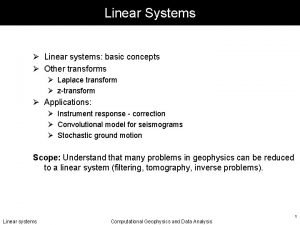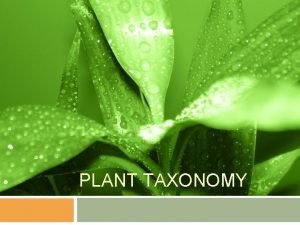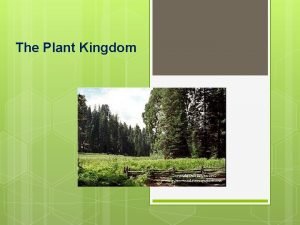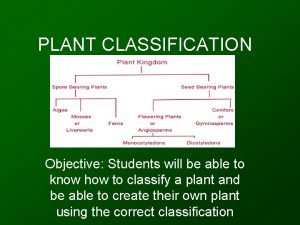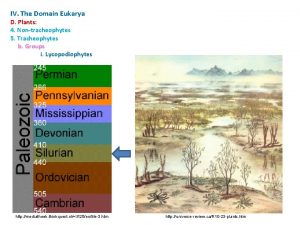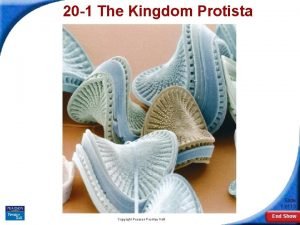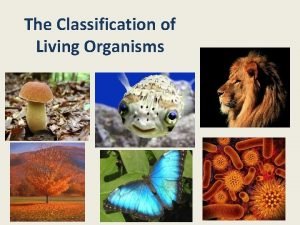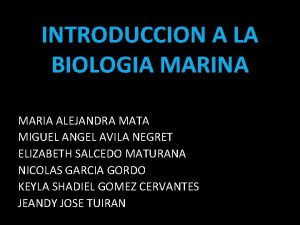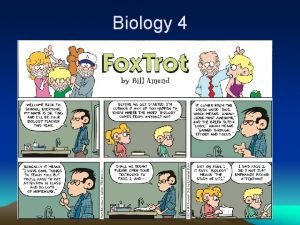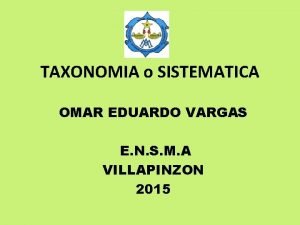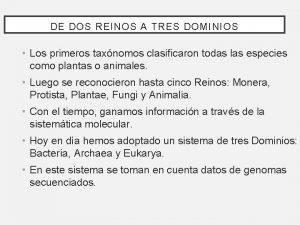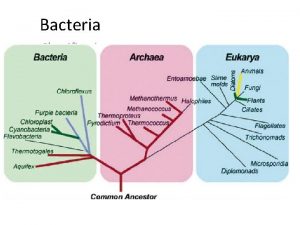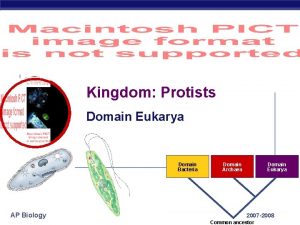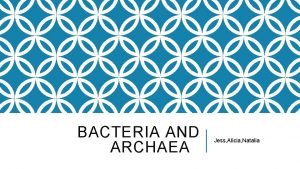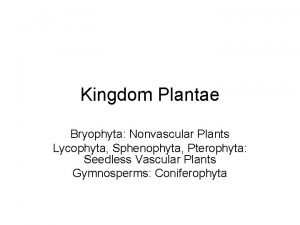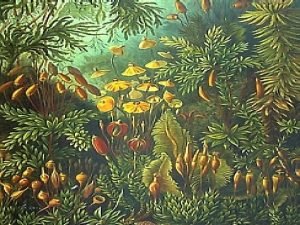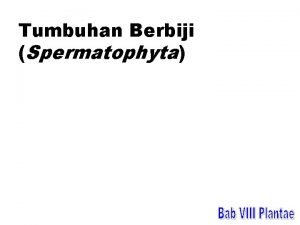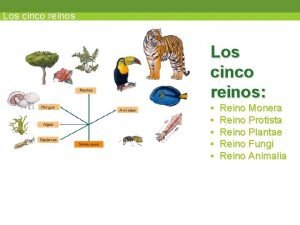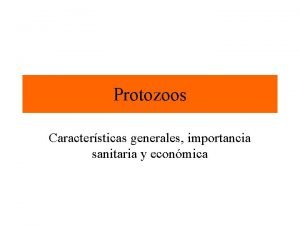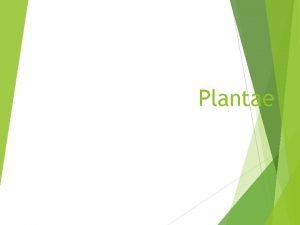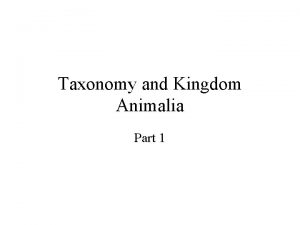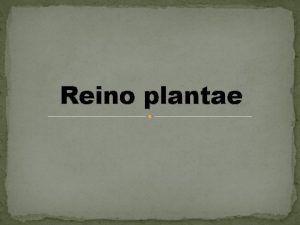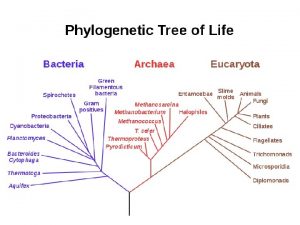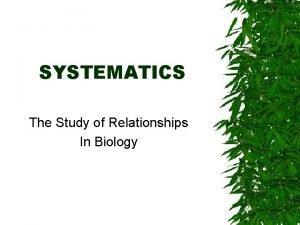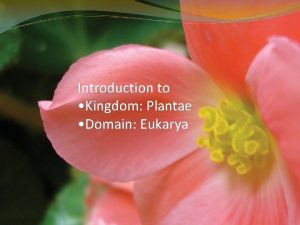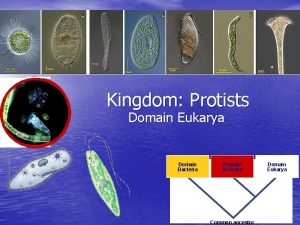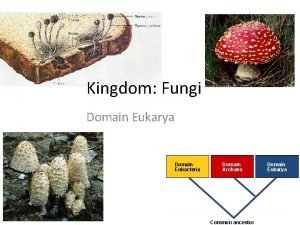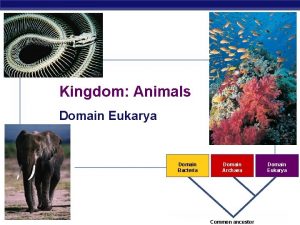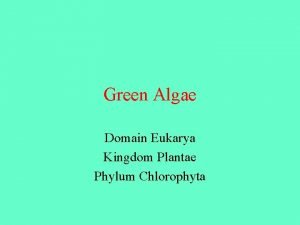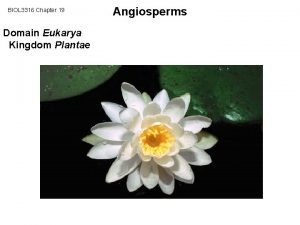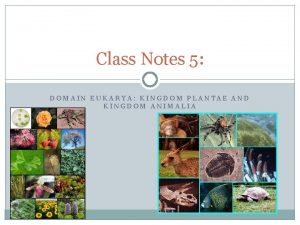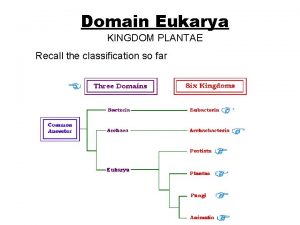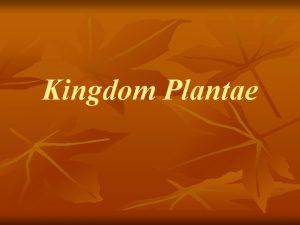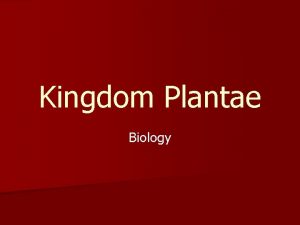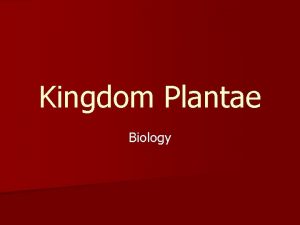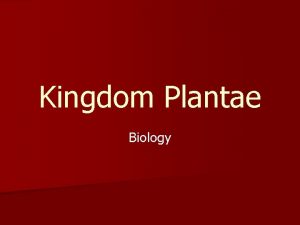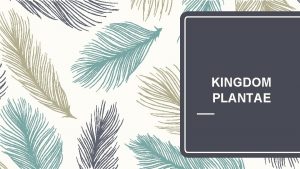Domain Eukarya Kingdom Plantae What makes a plant























































































































- Slides: 119

Domain Eukarya Kingdom Plantae What makes a plant? • Cell wall primarily of cellulose • Starch as primary photosynthetic storage product • Multicellular with complex specialized tissue development • Chl a, Chl b, xanthophylls, carotenoids

Plant evolution simplified Radiates from simple to more complex – in both form and environments • Seedless non-vascular • Seedless vascular • Seed producing, vascular, fruits/flowers

Semi-aquatic to more terrestrial • Ancestral “plants” transitions to primitive plants – Requirements met from aquatic environment • Gas, water, light, buoyancy support • Complex plants – Adapt to two environments • Shoot system • Root system

Plants: categorized by structures and lifecycles… Alternation of Generations

Moss sporophytes and gametophytes sporophytes gametophytes

Moss antheridia Sperm

Moss antheridia w/sperm

Moss archegonia ovum

Moss archegonia 2 ova

Moss archegonia 3

Moss sporophytes

Operculum Moss capsule (sporophyte) Spores

Liverwort

Liverwort antheridiophore

Liverwort antheridiophore 2

Liverwort antheridia Antheridiophore sperm

Liverwort antheridia w/sperm

Liverwort archegoniophore

Liverwort archegonia w/ova Archegoniophore ovum Archegonium

Liverwort sporophyte Archegoniophore

Liverwort sporophyte 2 spores

Liverwort gemmae cups(cupules)

Gemmae cups (cupules) Gemma cup (cupule) gemma

Hornwort sporophytes gametophyte

Hornwort 2 “Horn –like” Sporophyte gametophyte

Tracheophytes • Ferns and “fern allies” • Seedless • Vascular plants – Xylem composed of Tracheids – tapered porous cells • capillary action moderately efficient • Sporophyte dominant ancestral e. g. Rhyniophyta

Psilophyta

Psilophyta gametophyte

Lycophyta strobila leaves

Lycophyta strobilus microspores sporophylls megaspores

Lycophyta strobilus 2 Megaspores megsporangium Microspores

Lycophyta gametophyte

Sphenophyta strobilus

Sphenophyta strobilus

Sphenophyta gametophyte

Pterophyta sporophyte

Pterophyta sporophyte 2

Fern frond w/ sori

Sori on fern leaflets

Sorus

Fern sporangia Spores Annulus Sporangium

Fern sporangia and spores

Fern gametophyte

Fern gametophyte

Gametophyte w/antheridia Gametophyte (prothallus) Antheridia sperm

Antheridia w/sperm Antheridium sperm

Gametophyte w/archegonia Archegonia

Gametophyte w/archegonia 2 Archegonia

Archegonia on surface of prothallus

Fern sporangium and prothallus Sporophyte Gametophyte (prothallus)

Fern Life Cycle

Seed producing plants Gymnosperms Angiosperms • Sporophyte dominant • Conifers & relatives • Heterosporous • Sporophyte dominant • Flowering plants • Heterosporous – Mega- and micro– Small gametophye matures in protected cones – Mega- and micro– Small gametophye matures in protected flowers • Female in ovulate cones • Male in staminate cones • Female in flower ovary • Male in flower anthers – Wind blown-pollen • Seeds protected in ovulate cone – Dispersed by wind, animal, water sometimes – Animal pollination and some wind-blown • Seeds protected in fruit – Dispersed by animal mostly

Seed? • • Ovule to seed Ovule: sporophyte tissue surrounding sporangia Seed coat: protective diploid tissue Embryo: diploid zygote develops to sporophyte Endosperm: nutritive tissue surrounding embryo to feed it until it can photosynthesize on its own

Evolutionary importance of Seeds • These plants produce pollen – Pollen produces sperm nuclei (no water requrd) • Expand over drier habitats – Very protective over seasons (dormancy) • Endosperm (embryonic food) – headstart • Seed dispersal not dependent on water – Collected and distributed further • Flowering plants…even further in fruits

Pine lifecycle a

Pine lifecycle b

Pinus staminate cones

Pinus Ovulate cone (mature)

Staminate cone with pollen Pollen grains (microspores or micorgametophytes)

Pinus microgametophytes (mature pollen grains) “Wing” Tube nucleus Generative nucleus

Pinus ovulate cone ovule megasporophyll

Pinus megasporophyll Megaspore mother cell Megasporophyll

Ovule w/megaspore mother cell Megaspore mother cell Ovule

Pinus Megagametophyte Ovule Ovum

Pollen tubes

Pollen tube 2 Ovule (megagametophyte)

Pinus seed Haploid endosperm (gametophyte tissue)

Cycadophyta (male)

Cycadophyta

Cycadophyta ovulate cones

Ginkgophyta

Ginkgophyta leaves

Ginkgo ovules/seeds (naked) ovules (naked) seeds

Ginkgo staminate cones

Gnetophyta Welwitschia mirabilis • found in Angolan desert • “desert onion”

Gnetophyta/Ephedra

Angiosperms /Anthophyta • • Flowering Plants (anth = flower) Seeds in a fruit (angio = container) Double fertilization (see life cycle) Like other pollen producers, is not dependent on water for fertilization

What is a flower?

Flower structure (corolla) (carpel) (calyx)

Plants: • Monecious – Has both sexes • Dioecious – Separate sexed plants Flowers: • • Perfect Imperfect Complete Incomplete Regular Irregular Inflorescences

Anther 1

Anther 2

Dehiscing anther Pollen grains

Angiosperm lifecycle

Mature pollen grains

Lilium ovary (immature)

Lilium ovule Megagametophyte (embryo sac) funiculus

A= plumule B= hypocotyl Dicot Seed C = cotyledon D = testa E = radicle E

Dicot seed germination Radicle

Monocot seed Embryo Testa Cotyledon Endosperm Plumule Radicle

Monocot seed germination

Vascular tissue • Transport water, nutrients and food between roots and shoots • System of xylem and phloem cells • Varied organization in roots & shoots

Xylem cells – mature cells that become lignified (thickened 2 o cellulose), dies, and perforates from lysosomes • Tracheids – Primitive vascular plants – Tapered, pits on ends, less capillary action vs. vessel elements • Vessel elements – – Less primitive vascular plants Pits on sides, open ends Stacked to form long tubes Advanced capillary action • Transpiration – Roots → shoots → leaves → out – Via: root pressure and diffusion, capillary pressure, negative pressure of evaporation and cohesion

Phloem cells – living cells that transport sugars (sap) • Sieve tubes – no nucleus nor organelles – Open sieve plates • Companion cells – Nucleated – Adjoined to sieve tubes via plasmodesmata – Controls sieve tubes; regulates movement • Translocation – Movement of sugars; sources to sinks leaves → roots, fruits, &/or meristems

Plant Structure • Apical meristem – Mitotic division – Stem & root tips – Primary growth (length) • Ground meristem – Mitotic division – Ground tissues: • Parenchyma – large; storage • Collenchyma – smaller; flexible support • Schlerenchyma – lignified; rigid support; woody • Cambium – Mitotic secondary growth – e. g. Vascular cambium – e. g. Cork cambium

Leaf bud Ground meristem

Leaf bud 2 Apical meristem Ground meristem Provascular tissue

Monocot root • Vascular bundles centered in roots • Cortex = outer layer • Pith = center tissue • Stele = pith + vascular tissue Dicot root

Monocot root 2 Parenchyma Pith (Parenchyma)

Monocot root 3 Endodermis

Dicot root 2 Parenchyma

Dicot root 3 Endodermis and casparian strip Pericycle Phloem Xylem Vascular cambium

• Vascular bundles – Xylem, phloem, and cambium in between – Scattered throughout monocot stems – Organized around periphery of dicots • Cambium – Mitotic secondary growth – e. g. Vascular cambium – e. g. Cork cambium

Monocot stem

Monocot stem 2 Sclerenchyma Outside Phloem Sieve element Companion cell Xylem vessel Air space Inside

Dicot stem

Dicot stem 2 phloem sclerenchyma Vascular cambium

Woody stem Summerwood Springwood

Woody stem 2 Cork Vascular cambium Phloem ray Xylem

Woody stem 3 Cork (collenchyma tissue) Vascular cambium

Fruit – ripened ovary that protects the seeds • Ripened? • Layers of the ovary = Pericarp – Exocarp • Outer layer /ovarian wall – Mesocarp • Middle layer – Endocarp • Inner/adjacent to ovules

Fleshy fruits • One or more ovarian layer is fleshy – Drupe • Endocarp is hardened; pit or stone • Peaches, nectarines, apricots, etc – Berry • All or most pericarp is fleshy • Grape, tomato, etc – Pepo • Berry with hard thick rind • Melons, pumpkins, etc – Hesperidium • Berry with leathery rind • Citrus – Pome • Swollen receptacle around ovary or core • Apple, pear

Dry fruits • Lacks fleshy tissue – Dehiscent fruits • Split along a seam to disperse seeds • Legumes – two seams • Capsules – multiple seams • Bean, pea pods, peanuts, etc – Indehiscent • Do not split on a seam • Achenes, grains, nuts • Corn, wheat, etc

• Simple fruits – Single ovary of one flower • Aggregate fruits – Many ovaries of one flower • Multiple fruits – Many ovaries of many clustered flowers (inflorescence) • Accessory fruits – Tissue other than ovary ripens (swollen)

What is a coconut? Fleshy? Dry? Other? Drupe: a single fleshy fruit with a hard stone which contains the single seed

Plant Hormones (Ch. 39) chemical communication and regulation • Auxins – Cell elongation – Apical dominance – Abscission suppression • Slows the shedding of leaves, flowers, fruits – Fruit maturation – Geotropism • Phototropism • Gravitropism A. The tips have been removed. No auxin is produced and the shoots do not grow longer. B. The tips have been covered so light cannot reach them. Auxin is in the same concentration on both sides of the shoots, so they grow longer evenly on both sides. C. One side of the tips are in more light than the other side. Auxin is in a greater concentration on the shaded side, causing the cells there to grow longer than the cells on the light side.

Plant Hormones (Ch. 39) chemical communication and regulation • Giberellins – GA or Giberellic acid – Growth • Release some buds and seeds from dormancy • Dwarf plants lack GA – Spray on grapes = bigger grapes • Stem elongation – Spray on dwarf plants = taller plants • Related to flowering in some plants Sold as common bio-fertilizer

Plant Hormones (Ch. 39) chemical communication and regulation • Cytokinins – Cell division – Stimulate bud growth – Stimulates fruit & embryo development – Prevents leaf senescence • Slows aging to decay With & without

Plant Hormones (Ch. 39) chemical communication and regulation • Abscisic Acid – General growth inhibitor – Induces dormancy • Wintering of buds and leaves – Closure of stomata • Ethylene – Gaseous hormone – Plays role in fruit ripening – Fruit abscission • (shedding) – One of the reasons why ripe bananas will “ripen” other fruits
 Plant
Plant Protista domain
Protista domain What is fungi domain
What is fungi domain Domain eukarya kingdom fungi
Domain eukarya kingdom fungi Domain of animalia
Domain of animalia Coelom
Coelom Characteristics of the eukarya domain
Characteristics of the eukarya domain Domain eukarya kingdom fungi
Domain eukarya kingdom fungi Which are all members of the domain eukarya
Which are all members of the domain eukarya All vertebrate animals are in domain
All vertebrate animals are in domain Protista mobility
Protista mobility Share
Share Multicellular eukaryotic autotrophic organisms
Multicellular eukaryotic autotrophic organisms Flowering plants phylum
Flowering plants phylum Youtube egypt
Youtube egypt Capital of egypt during the old kingdom
Capital of egypt during the old kingdom Nnn ruled
Nnn ruled Old kingdom middle kingdom new kingdom
Old kingdom middle kingdom new kingdom Cvien
Cvien Is eubacteria in the domain eukarya
Is eubacteria in the domain eukarya Domain eukarya
Domain eukarya Domain eukarya kingdoms
Domain eukarya kingdoms Cladophorophyceae
Cladophorophyceae Domain vs kingdom
Domain vs kingdom Phaeophyta structure
Phaeophyta structure Tubuh marchantie berupa
Tubuh marchantie berupa Archaebacteria body form
Archaebacteria body form Lycodiophyta
Lycodiophyta Ferns kingdom
Ferns kingdom Subkingdom of kingdom plantae
Subkingdom of kingdom plantae Taxonomy in biology
Taxonomy in biology Diagram of plantae
Diagram of plantae Animalia eukaryotic
Animalia eukaryotic Protista, fungi, plantae, animalia *
Protista, fungi, plantae, animalia * Introduction of kingdom plantae
Introduction of kingdom plantae Nonvascular plants
Nonvascular plants Kingdom plantae
Kingdom plantae Disadvantages of mosses
Disadvantages of mosses Plantae characteristics
Plantae characteristics Ferns
Ferns A multicellular autotrophic organism with vascular tissue
A multicellular autotrophic organism with vascular tissue Eubacteria kingdom
Eubacteria kingdom Kingdom plantae chart
Kingdom plantae chart Character of plantae
Character of plantae How do plantae get nutrients
How do plantae get nutrients Animalia cladogram
Animalia cladogram What is the odds and ends kingdom
What is the odds and ends kingdom Bird stitching leaves
Bird stitching leaves 3 functions of leaves
3 functions of leaves Diatoms domain
Diatoms domain Systematic position of horse
Systematic position of horse Domain kingdom
Domain kingdom Domain family genus species
Domain family genus species Kingdom family genus species
Kingdom family genus species Euglena kingdom
Euglena kingdom Phylum order
Phylum order Kingdom and domain
Kingdom and domain What kingdom is archaea in
What kingdom is archaea in Levels of classification domain
Levels of classification domain In the hierarchy of classification which grouping
In the hierarchy of classification which grouping Human domain and kingdom
Human domain and kingdom Linnaeus
Linnaeus Kingdom phylum class order family genus and species
Kingdom phylum class order family genus and species Fibrobacteria
Fibrobacteria 3 domain scheme and 5 kingdom scheme
3 domain scheme and 5 kingdom scheme Bacteria grouping
Bacteria grouping Taxonomy of a squid
Taxonomy of a squid Ascomycete
Ascomycete 8 levels of classification in order
8 levels of classification in order Domain animal kingdom
Domain animal kingdom Codium life cycle
Codium life cycle Archaebacteria eubacteria
Archaebacteria eubacteria I am covered in dry scales and i lay eggs. what am i?
I am covered in dry scales and i lay eggs. what am i? Grasshopper domain kingdom phylum
Grasshopper domain kingdom phylum Internal anatomy of the squid
Internal anatomy of the squid![What is the z - transform of anu[n] and -anu[-n-1] What is the z - transform of anu[n] and -anu[-n-1]](data:image/svg+xml,%3Csvg%20xmlns=%22http://www.w3.org/2000/svg%22%20viewBox=%220%200%20200%20200%22%3E%3C/svg%3E) What is the z - transform of anu[n] and -anu[-n-1]
What is the z - transform of anu[n] and -anu[-n-1] Problem domain vs knowledge domain
Problem domain vs knowledge domain Codomain
Codomain The z transform of np
The z transform of np S domain to z domain
S domain to z domain Z domain to frequency domain
Z domain to frequency domain Domain specific vs domain general
Domain specific vs domain general Application domain and execution domain
Application domain and execution domain Data domain fundamentals
Data domain fundamentals Domain specific vs domain general
Domain specific vs domain general Plant order classification
Plant order classification Plant kingdom characteristics
Plant kingdom characteristics Plant kingdom classification
Plant kingdom classification Plant breeding for disease resistance
Plant breeding for disease resistance Tronsmo plant pathology and plant diseases download
Tronsmo plant pathology and plant diseases download Tronsmo plant pathology and plant diseases download
Tronsmo plant pathology and plant diseases download Plant introduction in plant breeding
Plant introduction in plant breeding Define plant breeding
Define plant breeding Tronsmo plant pathology and plant diseases download
Tronsmo plant pathology and plant diseases download Lycopodiophytes
Lycopodiophytes Protist evolution
Protist evolution Imagenes del reino protista
Imagenes del reino protista Domains biology
Domains biology Dominio eukarya
Dominio eukarya Prokaryotic cells
Prokaryotic cells Eukarya
Eukarya Clasificación de la papa
Clasificación de la papa Los tres dominios son
Los tres dominios son Eukarya
Eukarya Bacteria vs archaea vs eukarya
Bacteria vs archaea vs eukarya Protist is
Protist is Domain in biology
Domain in biology Life cycle of bacteria
Life cycle of bacteria Pterophyta plants
Pterophyta plants Karioteka
Karioteka Contoh tanaman monokotil
Contoh tanaman monokotil Bagian bagian lumut hati
Bagian bagian lumut hati Clasificacion del reino monera
Clasificacion del reino monera Importancia sanitaria de los protozoarios
Importancia sanitaria de los protozoarios Sphagnum moss
Sphagnum moss Animalia plantae
Animalia plantae Monera protista fungi plantae and animalia
Monera protista fungi plantae and animalia Cómo se llaman las plantas sin flores
Cómo se llaman las plantas sin flores Protista, fungi, plantae, animalia *
Protista, fungi, plantae, animalia * Monera protista fungi plantae animalia
Monera protista fungi plantae animalia
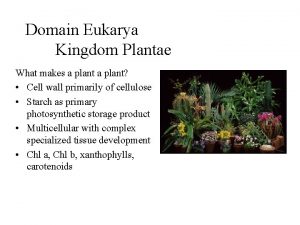


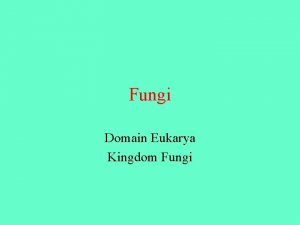

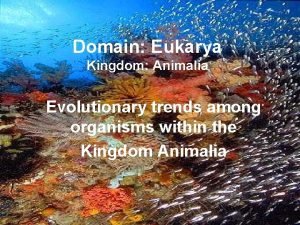

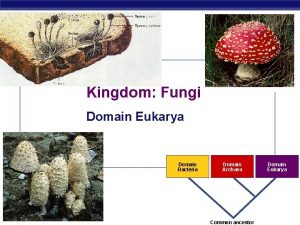
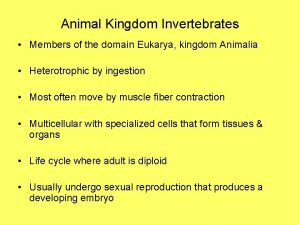
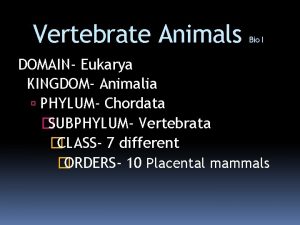


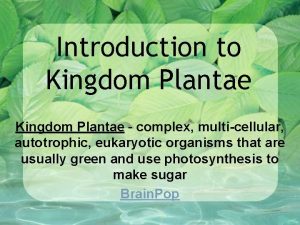
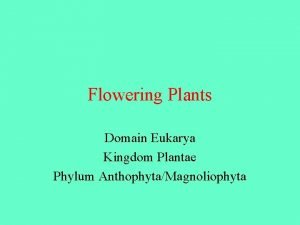




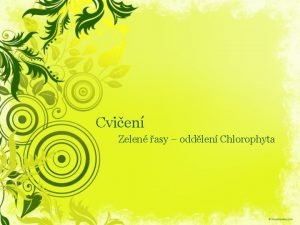


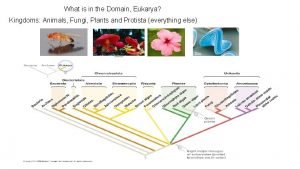
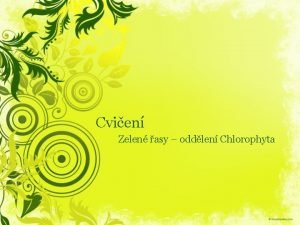
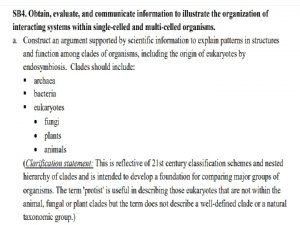
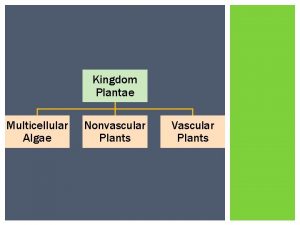
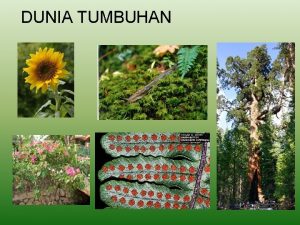

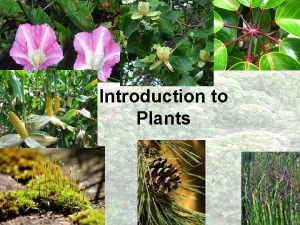
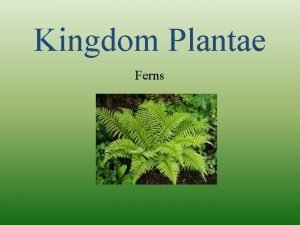
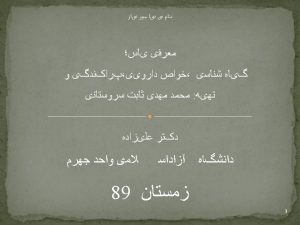

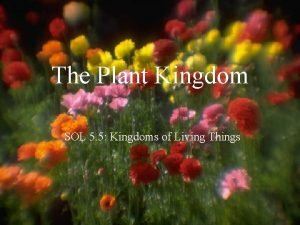



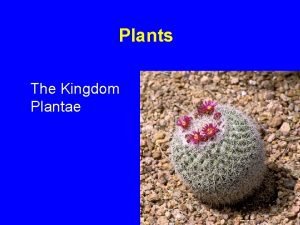
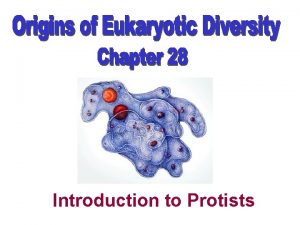
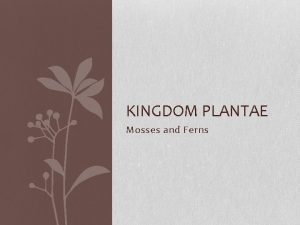

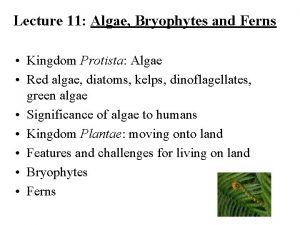


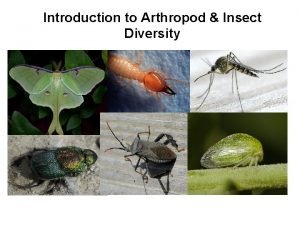

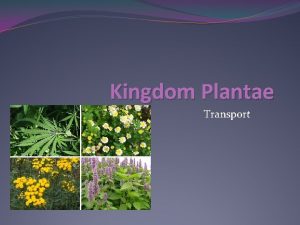



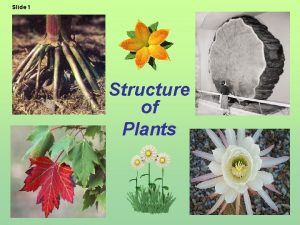
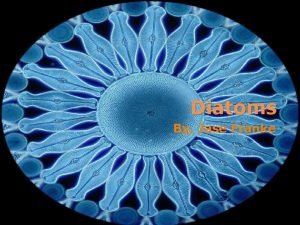

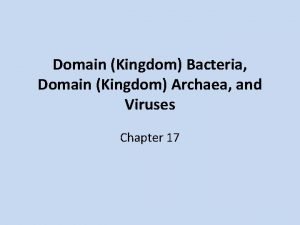


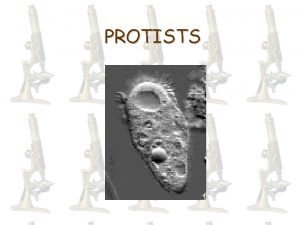


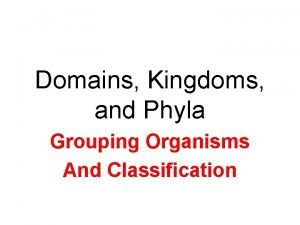

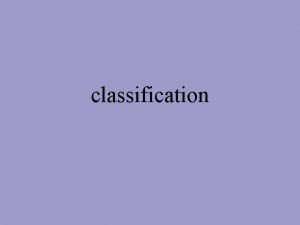
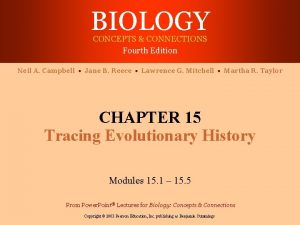

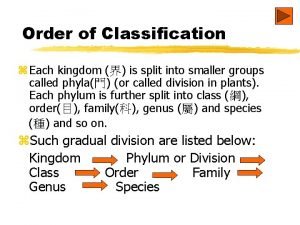
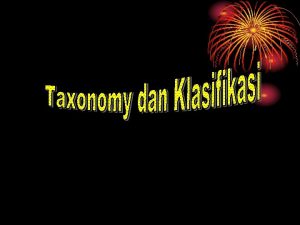

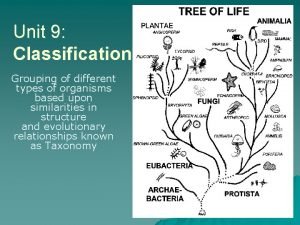
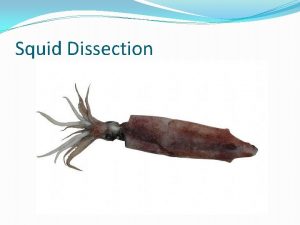
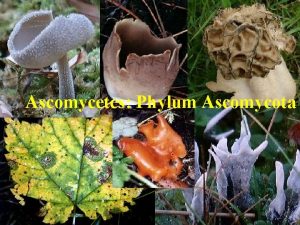
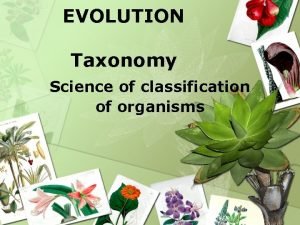
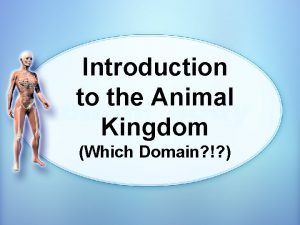
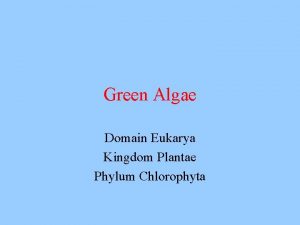

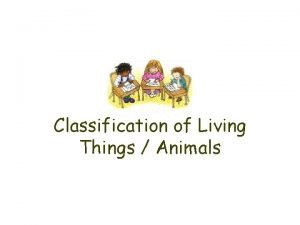
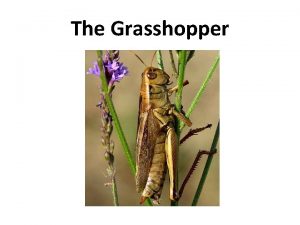
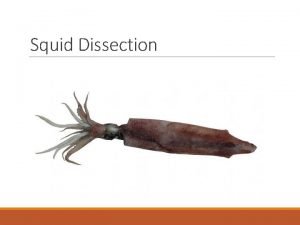
![What is the z - transform of anu[n] and -anu[-n-1] What is the z - transform of anu[n] and -anu[-n-1]](https://slidetodoc.com/wp-content/uploads/2020/12/2676408_bc1105d747f6a28db864208443624449-300x225.jpg)



